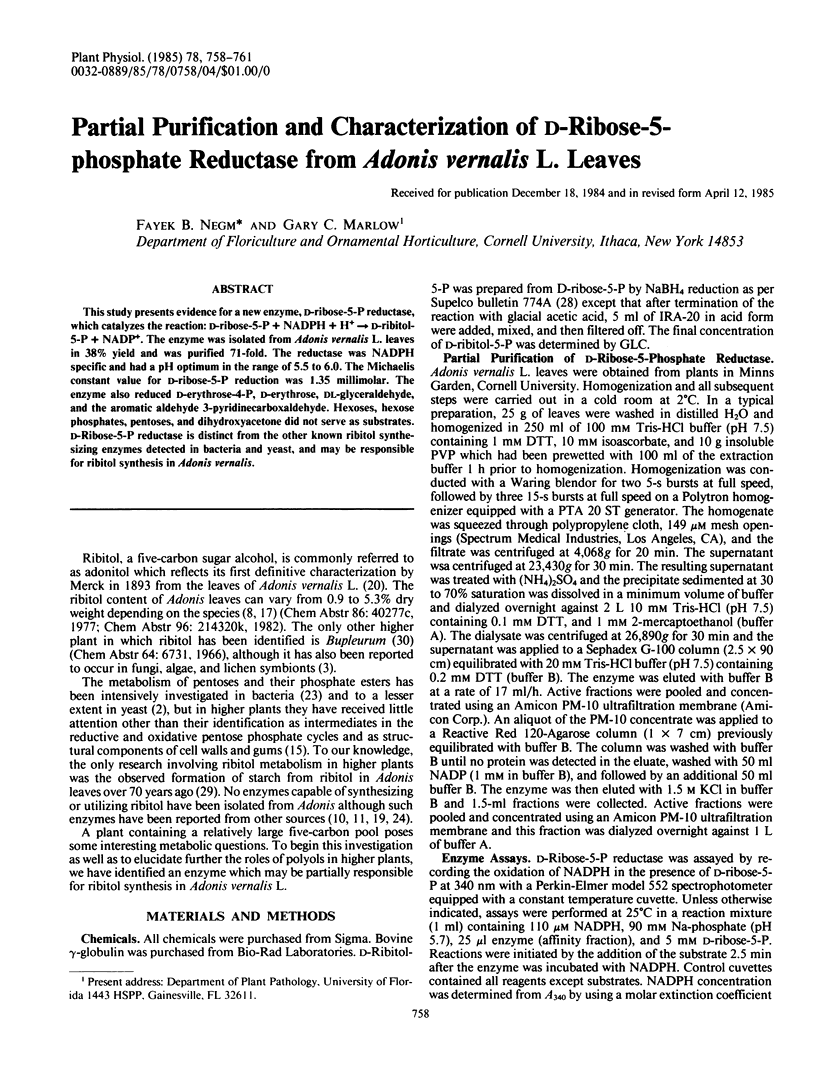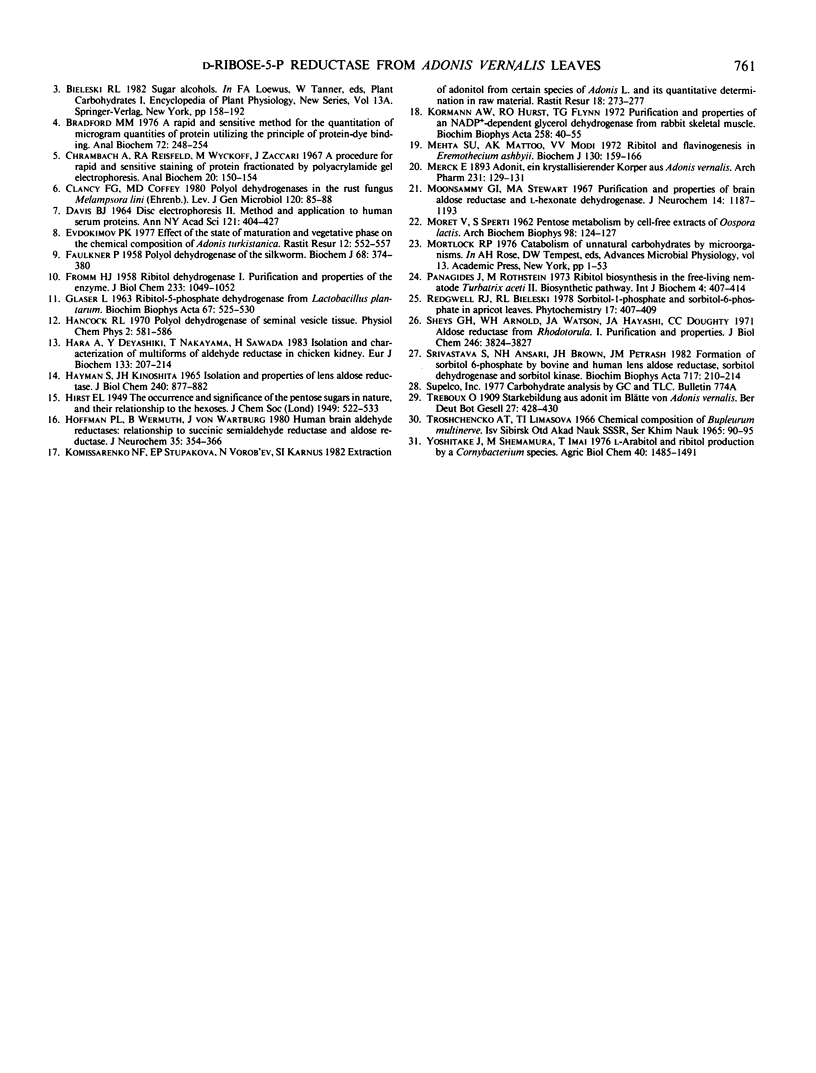Abstract
This study presents evidence for a new enzyme, d-ribose-5-P reductase, which catalyzes the reaction: d-ribose-5-P + NADPH + H+ → d-ribitol-5-P + NADP+. The enzyme was isolated from Adonis vernalis L. leaves in 38% yield and was purified 71-fold. The reductase was NADPH specific and had a pH optimum in the range of 5.5 to 6.0. The Michaelis constant value for d-ribose-5-P reduction was 1.35 millimolar. The enzyme also reduced d-erythrose-4-P, d-erythrose, dl-glyceraldehyde, and the aromatic aldehyde 3-pyridinecarboxaldehyde. Hexoses, hexose phosphates, pentoses, and dihydroxyacetone did not serve as substrates. d-Ribose-5-P reductase is distinct from the other known ribitol synthesizing enzymes detected in bacteria and yeast, and may be responsible for ribitol synthesis in Adonis vernalis.
Full text
PDF



Selected References
These references are in PubMed. This may not be the complete list of references from this article.
- Attwood M. A., Doughty C. C. Purification and properties of calf liver aldose reductase. Biochim Biophys Acta. 1974 Dec 29;370(2):358–368. doi: 10.1016/0005-2744(74)90097-7. [DOI] [PubMed] [Google Scholar]
- Barnett J. A. The utilization of sugars by yeasts. Adv Carbohydr Chem Biochem. 1976;32:125–234. doi: 10.1016/s0065-2318(08)60337-6. [DOI] [PubMed] [Google Scholar]
- Bradford M. M. A rapid and sensitive method for the quantitation of microgram quantities of protein utilizing the principle of protein-dye binding. Anal Biochem. 1976 May 7;72:248–254. doi: 10.1016/0003-2697(76)90527-3. [DOI] [PubMed] [Google Scholar]
- Chrambach A., Reisfeld R. A., Wyckoff M., Zaccari J. A procedure for rapid and sensitive staining of protein fractionated by polyacrylamide gel electrophoresis. Anal Biochem. 1967 Jul;20(1):150–154. doi: 10.1016/0003-2697(67)90272-2. [DOI] [PubMed] [Google Scholar]
- DAVIS B. J. DISC ELECTROPHORESIS. II. METHOD AND APPLICATION TO HUMAN SERUM PROTEINS. Ann N Y Acad Sci. 1964 Dec 28;121:404–427. doi: 10.1111/j.1749-6632.1964.tb14213.x. [DOI] [PubMed] [Google Scholar]
- FAULKNER P. Polyol dehydrogenase of the silkworm. Biochem J. 1958 Feb;68(2):374–380. doi: 10.1042/bj0680374. [DOI] [PMC free article] [PubMed] [Google Scholar]
- FROMM H. J. Ribitol dehydrogenase. I. Purification and properties of the enzyme. J Biol Chem. 1958 Nov;233(5):1049–1052. [PubMed] [Google Scholar]
- GLASER L. Ribitol-5-phosphate dehydrogenase from Lactobacillus plantarum. Biochim Biophys Acta. 1963 Apr 9;67:525–530. doi: 10.1016/0006-3002(63)91863-8. [DOI] [PubMed] [Google Scholar]
- HAYMAN S., KINOSHITA J. H. ISOLATION AND PROPERTIES OF LENS ALDOSE REDUCTASE. J Biol Chem. 1965 Feb;240:877–882. [PubMed] [Google Scholar]
- Hara A., Deyashiki Y., Nakayama T., Sawada H. Isolation and characterization of multiforms of aldehyde reductase in chicken kidney. Eur J Biochem. 1983 Jun 1;133(1):207–214. doi: 10.1111/j.1432-1033.1983.tb07449.x. [DOI] [PubMed] [Google Scholar]
- Hoffman P. L., Wermuth B., von Wartburg J. P. Human brain aldehyde reductases: relationship to succinic semialdehyde reductase and aldose reductase. J Neurochem. 1980 Aug;35(2):354–366. doi: 10.1111/j.1471-4159.1980.tb06272.x. [DOI] [PubMed] [Google Scholar]
- Kormann A. W., Hurst R. O., Flynn T. G. Purification and properties of an NADP + -dependent glycerol dehydrogenase from rabbit skeletal muscle. Biochim Biophys Acta. 1972 Jan 20;258(1):40–55. doi: 10.1016/0005-2744(72)90965-5. [DOI] [PubMed] [Google Scholar]
- MORET V., SPERTI S. Pentose metabolism by cell-free extracts of oospora lactis. Arch Biochem Biophys. 1962 Jul;98:124–127. doi: 10.1016/0003-9861(62)90156-x. [DOI] [PubMed] [Google Scholar]
- Mehta S. U., Mattoo A. K., Modi V. V. Ribitol and flavinogenesis in Eremothecium ashbyii. Biochem J. 1972 Nov;130(1):159–166. doi: 10.1042/bj1300159. [DOI] [PMC free article] [PubMed] [Google Scholar]
- Moonsammy G. I., Stewart M. A. Purification and properties of brain aldose reductase and L-hexonate dehydrogenase. J Neurochem. 1967 Dec;14(12):1187–1193. doi: 10.1111/j.1471-4159.1967.tb06166.x. [DOI] [PubMed] [Google Scholar]
- Sheys G. H., Arnold W. J., Watson J. A., Hayashi J. A., Doughty C. C. Aldose reductase from Rhodotorula. I. Purification and properties. J Biol Chem. 1971 Jun 25;246(12):3824–3827. [PubMed] [Google Scholar]
- Srivastava S. K., Ansari N. H., Brown J. H., Petrash J. M. Formation of sorbitol 6-phosphate by bovine and human lens aldose reductase, sorbitol dehydrogenase and sorbitol kinase. Biochim Biophys Acta. 1982 Aug 6;717(2):210–214. doi: 10.1016/0304-4165(82)90171-4. [DOI] [PubMed] [Google Scholar]


